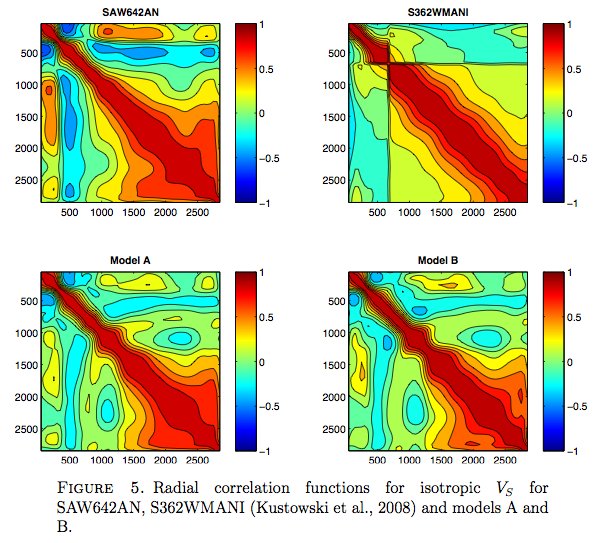SAW642ANb: updating a global radially anisotropic mantle shear velocity model with improved crustal corrections
References
Panning, M.P., V. Lekic, and B.A. Romanowicz, "The importance of crustal corrections in the development of a new global model of radial anisotropy" J. Geophys. Res., 115, B12325, doi:10.1029/2010JB007520, 2010.
Lekic, V., M.P. Panning, and B.A. Romanowicz, "A simple method for improving crustal corrections in waveform tomography", Geophys. J. Int., 182, 265-278, doi:10.1111/j.1365-246X.2010.04602.x, 2010.
Model files available for download:
gzipped tarfile (~2.9 MB)
The distribution includes all necessary model files (including the earlier model SAW642AN and models A through D discussed in the paper), as well as some tools for obtaining model values at specified locations in the mantle and making some basic plots. To use these tools, you will need C and Fortran90 compilers. Try the GNU compiler collection if you do not already have these available on your system. Some sample plotting scripts for plotting depth slices and cross sections are also included. These require GMT and the ability to run csh scripts (standard in Unix, linux, and OS X systems).
This model was developed at the University of Florida, in collaboration with the Berkeley Seismological Laboratory.
Summary (adapted from paper abstract):
 Accurately inferring the radially anisotropic structure of the
mantle using seismic waveforms requires correcting for the effects of crustal
structure on waveforms. Recent studies have quantified the importance of
accurate crustal corrections when mapping upper mantle structure using surface waves and overtones. Here, we explore the effects of crustal corrections
on the retrieval of deep mantle velocity and radial anisotropy structure. We
apply a new method of non-linear crustal corrections to a 3 component surface and body waveform dataset, and invert for a suite of models of radially
anisotropic shear velocity. We then compare the retrieved models against each
other and a model derived from an identical dataset, but using a different
non-linear crustal correction scheme. While retrieval of isotropic strucure in
the deep mantle appears to be robust with respect to changes in crustal corrections, we find large differences in anisotropic structure that result from
the use of different crustal corrections, particularly at transition zone and
greater depths. Furthermore, anisotropic structure in the lower mantle, including the depth-averaged signature in the core-mantle boundary region,
appears to be quite sensitive to choices of crustal correction. Our new preferred model, SAW642ANb, shows improvement in data fit and reduction
in apparent crustal artifacts. We argue that the accuracy of crustal corrections may currently be a limiting factor for improved resolution and agreement between models of mantle anisotropy.
Accurately inferring the radially anisotropic structure of the
mantle using seismic waveforms requires correcting for the effects of crustal
structure on waveforms. Recent studies have quantified the importance of
accurate crustal corrections when mapping upper mantle structure using surface waves and overtones. Here, we explore the effects of crustal corrections
on the retrieval of deep mantle velocity and radial anisotropy structure. We
apply a new method of non-linear crustal corrections to a 3 component surface and body waveform dataset, and invert for a suite of models of radially
anisotropic shear velocity. We then compare the retrieved models against each
other and a model derived from an identical dataset, but using a different
non-linear crustal correction scheme. While retrieval of isotropic strucure in
the deep mantle appears to be robust with respect to changes in crustal corrections, we find large differences in anisotropic structure that result from
the use of different crustal corrections, particularly at transition zone and
greater depths. Furthermore, anisotropic structure in the lower mantle, including the depth-averaged signature in the core-mantle boundary region,
appears to be quite sensitive to choices of crustal correction. Our new preferred model, SAW642ANb, shows improvement in data fit and reduction
in apparent crustal artifacts. We argue that the accuracy of crustal corrections may currently be a limiting factor for improved resolution and agreement between models of mantle anisotropy.

This research was partially supported by NSF grant EAR0911414. Support for V.L. provided in part by NSF Graduate Fellowship.